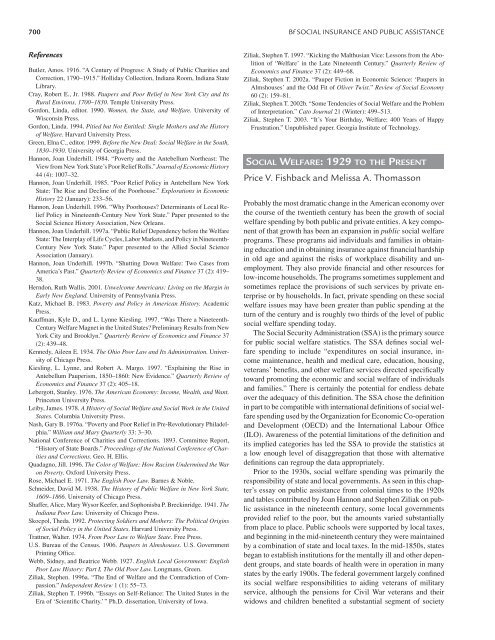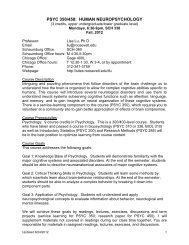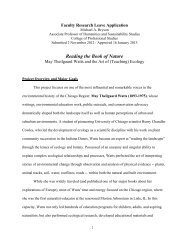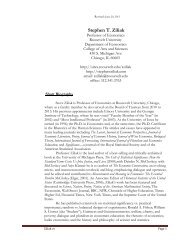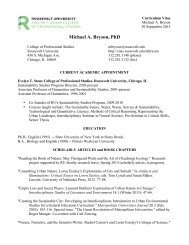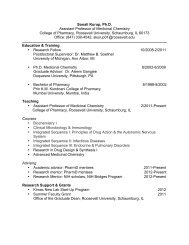Social Insurance and Public Assistance
public-assistance-welfare-reform-colonial-times-to-the-present-ziliak ...
public-assistance-welfare-reform-colonial-times-to-the-present-ziliak ...
Create successful ePaper yourself
Turn your PDF publications into a flip-book with our unique Google optimized e-Paper software.
700 Bf SOCIAL INSURANCE AND PUBLIC ASSISTANCE<br />
References<br />
Butler, Amos. 1916. “A Century of Progress: A Study of <strong>Public</strong> Charities <strong>and</strong><br />
Correction, 1790–1915.” Holliday Collection, Indiana Room, Indiana State<br />
Library.<br />
Cray, Robert E., Jr. 1988. Paupers <strong>and</strong> Poor Relief in New York City <strong>and</strong> Its<br />
Rural Environs, 1700–1830. Temple University Press.<br />
Gordon, Linda, editor. 1990. Women, the State, <strong>and</strong> Welfare. University of<br />
Wisconsin Press.<br />
Gordon, Linda. 1994. Pitied but Not Entitled: Single Mothers <strong>and</strong> the History<br />
of Welfare. Harvard University Press.<br />
Green, Elna C., editor. 1999. Before the New Deal: <strong>Social</strong> Welfare in the South,<br />
1830–1930. University of Georgia Press.<br />
Hannon, Joan Underhill. 1984. “Poverty <strong>and</strong> the Antebellum Northeast: The<br />
View from New York State’s Poor Relief Rolls.” Journal of Economic History<br />
44 (4): 1007–32.<br />
Hannon, Joan Underhill. 1985. “Poor Relief Policy in Antebellum New York<br />
State: The Rise <strong>and</strong> Decline of the Poorhouse.” Explorations in Economic<br />
History 22 (January): 233–56.<br />
Hannon, Joan Underhill. 1996. “Why Poorhouses? Determinants of Local Relief<br />
Policy in Nineteenth-Century New York State.” Paper presented to the<br />
<strong>Social</strong> Science History Association, New Orleans.<br />
Hannon, Joan Underhill. 1997a. “<strong>Public</strong> Relief Dependency before the Welfare<br />
State: The Interplay of Life Cycles, Labor Markets, <strong>and</strong> Policy in Nineteenth-<br />
Century New York State.” Paper presented to the Allied <strong>Social</strong> Science<br />
Association (January).<br />
Hannon, Joan Underhill. 1997b. “Shutting Down Welfare: Two Cases from<br />
America’s Past.” Quarterly Review of Economics <strong>and</strong> Finance 37 (2): 419–<br />
38.<br />
Herndon, Ruth Wallis. 2001. Unwelcome Americans: Living on the Margin in<br />
Early New Engl<strong>and</strong>. University of Pennsylvania Press.<br />
Katz, Michael B. 1983. Poverty <strong>and</strong> Policy in American History. Academic<br />
Press.<br />
Kauffman, Kyle D., <strong>and</strong> L. Lynne Kiesling. 1997. “Was There a Nineteenth-<br />
Century Welfare Magnet in the United States? Preliminary Results from New<br />
York City <strong>and</strong> Brooklyn.” Quarterly Review of Economics <strong>and</strong> Finance 37<br />
(2): 439–48.<br />
Kennedy, Aileen E. 1934. The Ohio Poor Law <strong>and</strong> Its Administration. University<br />
of Chicago Press.<br />
Kiesling, L. Lynne, <strong>and</strong> Robert A. Margo. 1997. “Explaining the Rise in<br />
Antebellum Pauperism, 1850–1860: New Evidence.” Quarterly Review of<br />
Economics <strong>and</strong> Finance 37 (2): 405–18.<br />
Lebergott, Stanley. 1976. The American Economy: Income, Wealth, <strong>and</strong> Want.<br />
Princeton University Press.<br />
Leiby, James. 1978. A History of <strong>Social</strong> Welfare <strong>and</strong> <strong>Social</strong> Work in the United<br />
States. Columbia University Press.<br />
Nash, Gary B. 1976a. “Poverty <strong>and</strong> Poor Relief in Pre-Revolutionary Philadelphia.”<br />
William <strong>and</strong> Mary Quarterly 33: 3–30.<br />
National Conference of Charities <strong>and</strong> Corrections. 1893. Committee Report,<br />
“History of State Boards.” Proceedings of the National Conference of Charities<br />
<strong>and</strong> Corrections. Geo. H. Ellis.<br />
Quadagno, Jill. 1996. The Color of Welfare: How Racism Undermined the War<br />
on Poverty. Oxford University Press.<br />
Rose, Michael E. 1971. The English Poor Law. Barnes & Noble.<br />
Schneider, David M. 1938. The History of <strong>Public</strong> Welfare in New York State,<br />
1609–1866. University of Chicago Press.<br />
Shaffer, Alice, Mary Wysor Keefer, <strong>and</strong> Sophonisba P. Breckinridge. 1941. The<br />
Indiana Poor Law. University of Chicago Press.<br />
Skocpol, Theda. 1992. Protecting Soldiers <strong>and</strong> Mothers: The Political Origins<br />
of <strong>Social</strong> Policy in the United States. Harvard University Press.<br />
Trattner, Walter. 1974. From Poor Law to Welfare State. Free Press.<br />
U.S. Bureau of the Census. 1906. Paupers in Almshouses. U.S. Government<br />
Printing Office.<br />
Webb, Sidney, <strong>and</strong> Beatrice Webb. 1927. English Local Government: English<br />
Poor Law History: Part I, The Old Poor Law. Longmans, Green.<br />
Ziliak, Stephen. 1996a. “The End of Welfare <strong>and</strong> the Contradiction of Compassion.”<br />
Independent Review 1 (1): 55–73.<br />
Ziliak, Stephen T. 1996b. “Essays on Self-Reliance: The United States in the<br />
Era of ‘Scientific Charity.’ ” Ph.D. dissertation, University of Iowa.<br />
Ziliak, Stephen T. 1997. “Kicking the Malthusian Vice: Lessons from the Abolition<br />
of ‘Welfare’ in the Late Nineteenth Century.” Quarterly Review of<br />
Economics <strong>and</strong> Finance 37 (2): 449–68.<br />
Ziliak, Stephen T. 2002a. “Pauper Fiction in Economic Science: ‘Paupers in<br />
Almshouses’ <strong>and</strong> the Odd Fit of Oliver Twist.” Review of <strong>Social</strong> Economy<br />
60 (2): 159–81.<br />
Ziliak, Stephen T. 2002b. “Some Tendencies of <strong>Social</strong> Welfare <strong>and</strong> the Problem<br />
of Interpretation.” Cato Journal 21 (Winter): 499–513.<br />
Ziliak, Stephen T. 2003. “It’s Your Birthday, Welfare: 400 Years of Happy<br />
Frustration.” Unpublished paper. Georgia Institute of Technology.<br />
SOCIAL WELFARE: 1929 TO THE PRESENT<br />
Price V. Fishback <strong>and</strong> Melissa A. Thomasson<br />
Probably the most dramatic change in the American economy over<br />
the course of the twentieth century has been the growth of social<br />
welfare spending by both public <strong>and</strong> private entities. A key component<br />
of that growth has been an expansion in public social welfare<br />
programs. These programs aid individuals <strong>and</strong> families in obtaining<br />
education <strong>and</strong> in obtaining insurance against financial hardship<br />
in old age <strong>and</strong> against the risks of workplace disability <strong>and</strong> unemployment.<br />
They also provide financial <strong>and</strong> other resources for<br />
low-income households. The programs sometimes supplement <strong>and</strong><br />
sometimes replace the provisions of such services by private enterprise<br />
or by households. In fact, private spending on these social<br />
welfare issues may have been greater than public spending at the<br />
turn of the century <strong>and</strong> is roughly two thirds of the level of public<br />
social welfare spending today.<br />
The <strong>Social</strong> Security Administration (SSA) is the primary source<br />
for public social welfare statistics. The SSA defines social welfare<br />
spending to include “expenditures on social insurance, income<br />
maintenance, health <strong>and</strong> medical care, education, housing,<br />
veterans’ benefits, <strong>and</strong> other welfare services directed specifically<br />
toward promoting the economic <strong>and</strong> social welfare of individuals<br />
<strong>and</strong> families.” There is certainly the potential for endless debate<br />
over the adequacy of this definition. The SSA chose the definition<br />
in part to be compatible with international definitions of social welfare<br />
spending used by the Organization for Economic Co-operation<br />
<strong>and</strong> Development (OECD) <strong>and</strong> the International Labour Office<br />
(ILO). Awareness of the potential limitations of the definition <strong>and</strong><br />
its implied categories has led the SSA to provide the statistics at<br />
alow enough level of disaggregation that those with alternative<br />
definitions can regroup the data appropriately.<br />
Prior to the 1930s, social welfare spending was primarily the<br />
responsibility of state <strong>and</strong> local governments. As seen in this chapter’s<br />
essay on public assistance from colonial times to the 1920s<br />
<strong>and</strong> tables contributed by Joan Hannon <strong>and</strong> Stephen Ziliak on public<br />
assistance in the nineteenth century, some local governments<br />
provided relief to the poor, but the amounts varied substantially<br />
from place to place. <strong>Public</strong> schools were supported by local taxes,<br />
<strong>and</strong> beginning in the mid-nineteenth century they were maintained<br />
by a combination of state <strong>and</strong> local taxes. In the mid-1850s, states<br />
began to establish institutions for the mentally ill <strong>and</strong> other dependent<br />
groups, <strong>and</strong> state boards of health were in operation in many<br />
states by the early 1900s. The federal government largely confined<br />
its social welfare responsibilities to aiding veterans of military<br />
service, although the pensions for Civil War veterans <strong>and</strong> their<br />
widows <strong>and</strong> children benefited a substantial segment of society


